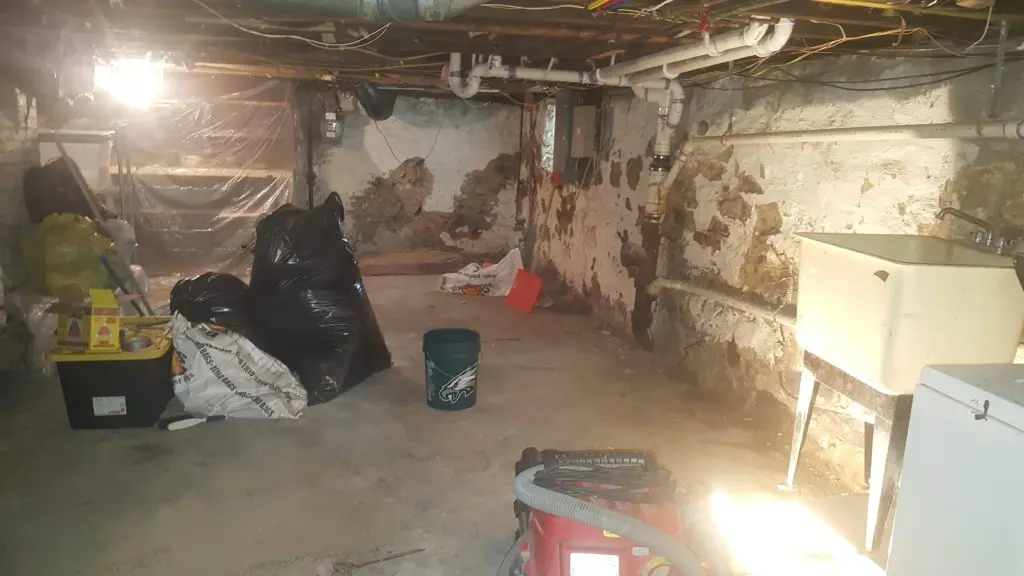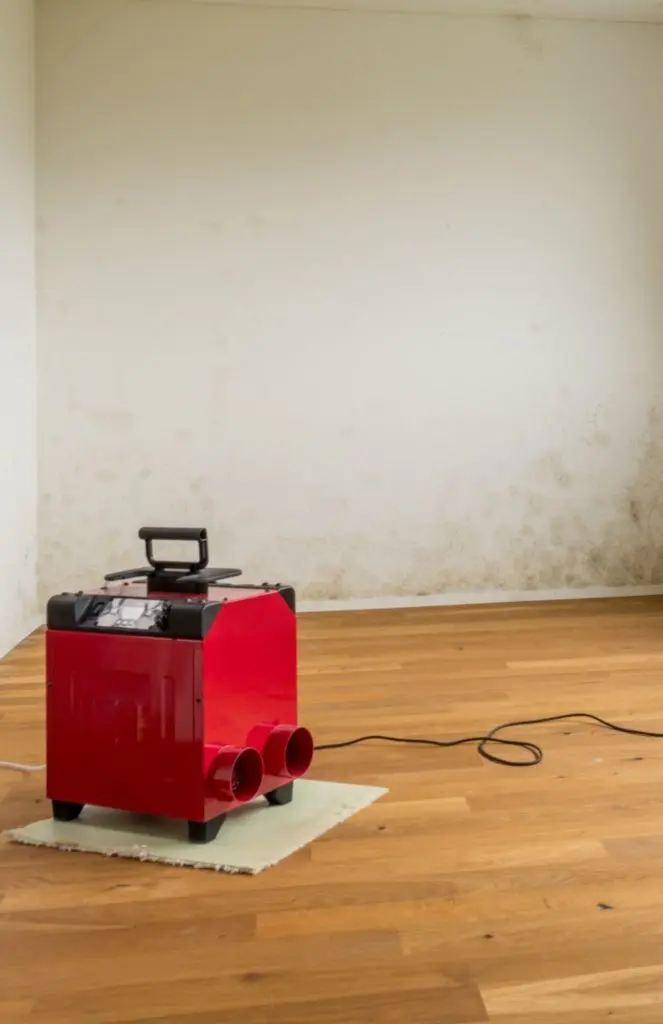The first sign of basement mold besides actually seeing it is a musty odor. If you open your basement door and a musty odor hits you, you very likely have a mold issue. The other visual cue that can be used is a white circular pattern on the overhead basement joist. This is the very common mold group called Aspergillus/Penicillium and it grows very rapidly and sometimes will not give off an odor. Aspergillus/Penicillium is known to cause a whole host of respiratory and immune reactions which mimic allergies and can make the occupants constantly feel under attack. Contact Moisture Science Environment for professional basement mold cleaning services today!
Basement Mold Cleaning in Philadelphia / South Jersey
Once mold begins to grow in your basement it will want to spread its wings and move to a less crowded environment. How does mold move out of the basement? It does so by forming spores and becoming airborne. If you look at mold under a microscope it is composed of millions of tiny cotton ball-looking parts. These are what go into the air and get pulled into your HVAC system and circulated to the other living areas or fall onto personal items that are then brought to the upper levels and it can spread from there. Mold infection is the second leading cause of sinusitis in adults. Mold also can exacerbate chronic conditions such as asthma, seasonal allergies, COPD, dermatitis, headaches and other immune disorders. It is simply not worth risking the health of your family or employees by ignoring mold contamination that can be solved with basement mold cleaning services.
MSE’s Professional Basement Mold Cleaning Process
Professional basement mold remediation involves a thorough and systematic process to identify, contain, remove, and prevent the recurrence of mold. Here’s an overview of the professional basement mold cleaning process.
- Comprehensive Inspection and Assessment: Our experienced team begins with a detailed assessment to identify the extent of the mold issue and pinpoint the sources of moisture. Utilizing advanced tools, such as moisture meters and infrared cameras, we ensure a thorough examination.
- Strategic Containment: Prior to initiating the cleaning process, we implement meticulous containment procedures. Our specialists seal off the affected area using high-grade plastic sheeting, creating a controlled environment to prevent the spread of mold spores.
- Advanced Air Filtration: Employing state-of-the-art high-efficiency particulate air (HEPA) filtration systems, we effectively capture and filter mold spores from the air throughout the remediation process, ensuring a clean and safe environment.
- Personal Protective Equipment (PPE): Our team prioritizes safety. Our technicians wear personal protective equipment, including respirators, gloves, and suits, to guarantee their safety during the mold remediation process.
- Expert Removal of Contaminated Materials: We meticulously remove and dispose of contaminated porous materials, such as drywall, carpeting, and insulation, to prevent any potential cross-contamination.
- Cleaning and Disinfection: Using specialized cleaning agents, our experts conduct a thorough cleaning and disinfection of non-porous surfaces. This involves targeted techniques, including scrubbing and sanding, to ensure complete mold elimination.
- High-Powered HEPA Vacuuming: Our industrial-strength vacuums equipped with HEPA filters are employed to clean surfaces comprehensively, capturing any remaining mold spores and debris.
- Professional Drying Procedures: After cleaning, we deploy advanced dehumidifiers and powerful fans to ensure the treated area is completely dry. This step is crucial because mold thrives on moisture.
- Proactive Preventive Measures: As part of our service, we may apply mold inhibitors to treated surfaces to discourage future mold growth. Our experts also offer recommendations for improving ventilation and addressing potential water leak sources.
- Thorough Post-Remediation Verification: To guarantee the success of the mold remediation process, we conduct a final inspection, including air quality testing to confirm that mold spore levels are within acceptable limits.
- Detailed Documentation: Moisture Science Environmental provides comprehensive documentation of the entire mold remediation process. This includes before-and-after photos, detailed test results, and a thorough report for insurance claims and client records.
Choose Moisture Science Environmental for basement mold cleaning and expert mold removal services. Our commitment to excellence ensures a safe, clean, and mold-free property.

Basement Mold Cleaning Timeline
Most basement mold cleaning projects take 1-2 days. This may be increased if there is a significant amount of personal items or other logistical issues.
5-Star Client Reviews
⭐⭐⭐⭐⭐
-M.H.
Basement Mold Prevention Tips
If you control the moisture you control the mold. This is a time-tested fact of homeownership. A wet or damp basement guarantees a mold problem. The easiest way to avoid this issue is to have a functionally dry basement. For basements that are found to be ‘damp’ as opposed to ‘wet’, a properly sized and placed dehumidifier with a built-in pump could be the only necessary remedy. Very often we will find a working dehumidifier that is either undersized, placed in the wrong location, or has a bucket that is full and hasn’t been emptied in weeks. The built-in pump is key because it eliminates the need for constantly having to empty the drain bucket. The dehumidifier being placed in a central location is also a big key. Placing a dehumidifier in a corner or at the far end of a basement or crawlspace will greatly reduce its ability to dry the entire space.
Another way to prevent mold is to eliminate the food sources of fungus. These include paper products such as cardboard boxes, magazines, and books as well as other sources such as wood furniture, textiles, and old carpeting. Any personal items that are not composed of plastic, glass, or metal should be stored in plastic bins with lids. If you have a concrete floor it is always a good idea not to store anything directly against that floor. Instead, purchase plastic or metal shelving and place all personal belongings on the shelves instead. Any personal item that is porous will wick moisture from the floor and potentially be a source of mold growth.

Basement Mold FAQs
Why am I getting basement mold?
There are numerous reasons why mold is found in the basement: leaky pipes, foundation cracks, etc.
Learn more about why am I getting mold in my basement?
What happens if there is mold in basement?
The accumulation of mold in the basement can lead to building up a potentially toxic environment in your basement, which might cause a host of adverse health issues similar to extreme allergies as well as worsening of asthma or COPD symptoms.
Learn more about the dangers of mold.
Is mold in basement toxic?
Some people are more sensitive or prone to the exposure to mold. Removing basement mold by a professional mold remediation company may increase your quality of life.
Contact Moisture Science to learn more.
Is it safe to live in a house with mold in the basement?
Mold can be unsafe for you and your family. Living in a house with a moldy basement can grow worse if left untreated. Mold spores can continue to accumulate as well as spread to other areas of the home.
Moisture Science advises families dealing with a moldy basement to schedule a professional mold inspector.
Where should a dehumidifier be placed in the basement?
Consider using a dehumidifier when the relative humidity remains high. The dehumidifier should be placed as central to the overall space as possible. The relative humidity should not exceed 60% in a basement so most dehumidifiers are set to 55% to be safe. Most importantly, a dehumidifier with BUILT-IN-PUMP should be used.
Having a dehumidifier that requires manually emptying ultimately leads to the drain bucket becoming full and the dehumidifier shutting off. This can lead to a rapid rise in relative humidity which causes mold.
While a dehumidifier may be an aid in mold management, it may not be a solution to your mold problem. Contact Moisture Science Environmental for professional basement mold cleaning services
Can basement mold affect upstairs?
Yes, basement mold growth can affect upstairs. All air in the basement is evenly pulled upstairs by what is known as the Stack Effect.
Learn more about how basement mold affects upstairs.

